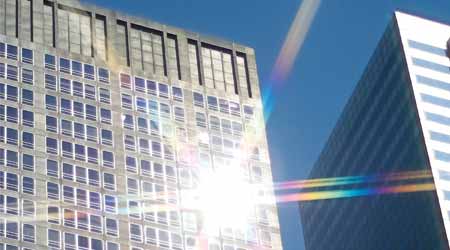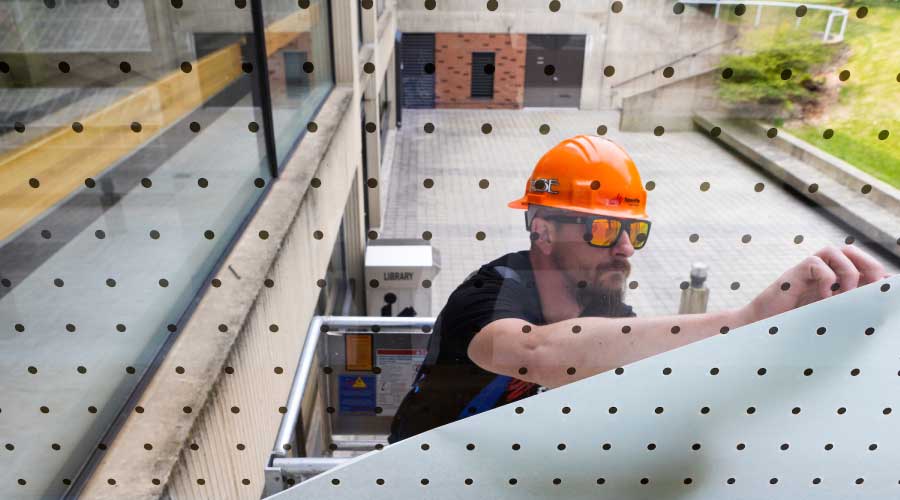How Low-E and Dynamic Glazings, Window Film, Reflective Coatings Can Save Energy
Part 2 of a three-part article on glazings and other energy efficient windows options.
Low-emissivity or low-e glazings use a thin, nearly transparent coating to limit the amount of ultraviolet and infrared wavelengths of light that can pass through glass, with little impact on the transmission of visible light.
In standard window glazings, any energy absorbed by the glazing is either conducted away or radiated away in the form of long-wave infrared energy — in other words, heat. This heat is radiated both into and away from the building. How much heat energy is radiated depends on the glazing’s emissivity rating. Uncoated window glass has an emissivity rating of .80 on average. Reducing the emissivity level of the glazing will greatly reduce the rate at which heat is radiated into the building during the cooling season.
Reduced glass emissivity levels will also reduce the rate at which heat is radiated out of the building through the windows during the heating season, resulting in year-round improved energy efficiency. The coating on low-e glazings reduce the emissivity level of the glass to values as low as .04.
Low-e glazings can improve energy efficiency in practically any climate, but are most cost effective in moderate to colder climates. While they can be used in any application, they are most effective in buildings having large areas of glass. A side benefit is that low-e glazings can reduce sun-induced fading of materials within the building.
Window film and reflective coatings
Window films and reflective coatings have been in use for more than 40 years to help limit solar heat gain through windows. Early-generation films and coatings simply absorbed energy across the entire solar spectrum, thus reducing visible light transmission as well as solar heat gain. In many cases, the visible light transmission was cut more than the solar heat gain. The result was rooms that were dim in appearance, often requiring the use of lighting in order to see. That was bad enough, but the process of absorbing the solar radiation caused the film to heat up. Since the film or coating was only attached to one of the glass surfaces, there was differential heating and expansion of the two glazings. This frequently resulted in stresses sufficient to break the window.
Today’s window films and coatings have been developed to selectively block the sun’s infrared radiation while admitting most of the visible light. By modifying the properties of the films and coatings, manufacturers can control how much visible light and infrared radiation are blocked, making them suitable for a wide range of applications and climates.
The majority of solar films and coatings have a solar heat gain coefficient rating of 1.2 or less. While it is possible to have ones with a light-to-solar-gain (LSG) ratio as high as 2.0, it is difficult to achieve. The higher the ratio, particularly if it is 1.0 or higher, the better suited it is for hot climates. While even low values can effectively block solar heat gain, they can produce a very dark appearance in spaces.
New technologies
Dynamic glazing offers facility managers a new option for energy-efficient glazing. Conventional window properties, such as transmission of visual light and infrared, are set for the life of the window at the date of manufacture. There are times when it would benefit the energy efficiency of the building if they could be changed based on the season or needs within the building. For example, allowing infrared radiation to enter the building during daylight in the heating season would reduce heating requirements, but having the ability to block it during the cooling season would also reduce energy use during the cooling season.
Dynamic glazings do just that. By changing the glazing’s characteristics, window energy properties can be matched to building requirements as they change. Units are available that can change automatically based on environmental conditions or manually by occupants. At this point, dynamic glazing is considerably more expensive than high-quality, energy-efficient windows, but costs are expected to fall over the next five years.
An interesting technology under development is the evacuated window. While the use of gases such as argon produce lower thermal conductivity through the window than air, the most efficient window would have no gas at all between the glazings. Having a near-vacuum between the glazings would greatly reduce conduction and convective heat transfer through the window, but it would do nothing for radiation heat transfer. Therefore these windows would also need a low-e coating.
A number of issues are yet to be resolved, including making the glazings strong enough to resist the bowing and flexing that windows are subject to as the result of wind and vibrations. Additionally, the seal along the window’s edges must be sufficiently strong to prevent even minor leaking over the lifetime of the window.
James Piper, PhD, PE, is a writer and consultant who has more than 35 years of experience in facilities management. He is a contributing editor for Building Operating Management.
Email comments to edward.sullivan@tradepress.com.
Related Topics:












